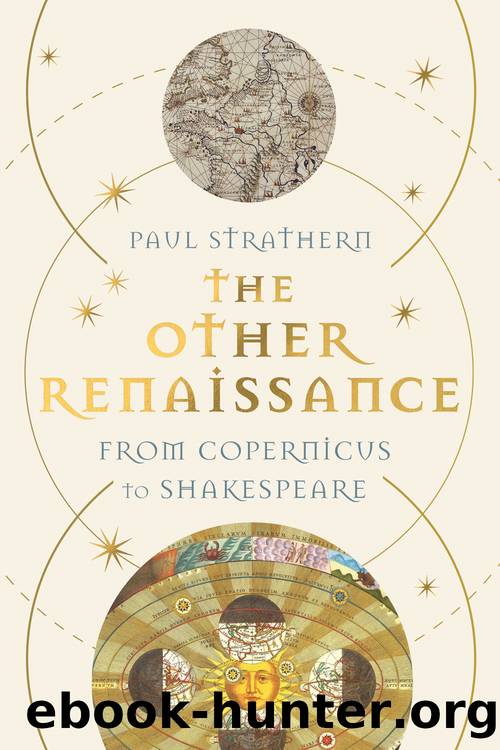The Other Renaissance by Paul Strathern;

Author:Paul Strathern;
Language: eng
Format: epub
Publisher: Lightning Source Inc. (Tier 3)
* Highly popular in the nineteenth century, this society followed a religion whose secret masters lived in remote locations throughout the world, but mainly in Tibet. These superhuman figures possessed great wisdom and occult powers derived from western Neoplatonism and eastern mysticism, as well as a melange of the ancient religions of India.
* The inclusion of such apparently superfluous posthumous metaphysics is intended to illustrate that the strain of irrationality is not confined to the remnants of medieval thought which lasted on into the Renaissance. The human mind throughout history has thrived on metaphysical beliefs â from the pyramids where the mummified pharaohs would rise to enter their âafter lifeâ, to the enjoyment of modern movies featuring exorcism, zombies, body-changing and the like. Humanism and the Renaissance may have inspired the human mind on its path to the modern world view, but even this latter also contains its seemingly necessary undercurrent of esoteric thought. From Faust to Frankenstein to Count Dracula, this never-ending cast of figures rises from our subconscious mind to march on beside us, at the edges of our vision. As with Paracelsus, such thought can, and still does, inform all manner of genuine scientific discovery. Today, research into AI (artificial intelligence) has brought huge technical advances, despite its quixotic striving to create âconsciousnessâ. Likewise the many advances effected by Elon Musk, fuelled by his belief that humanity will escape this polluted earth to thrive on barren planets.
â He would not take on his self-aggrandizing classical name until he was thirty-six and had so blotted his aristocratic moniker that he was no longer able to get away with practising as a physician under the name Theophrastus Bombastus von Hohenheim. I have used the name Paracelsus for the opposite reason â in order to avoid any misidentification such as he sought to perpetrate.
* Despite this typical claim, Paracelsus had almost certainly heard of the cure while travelling in Italy. The cure is known to have been discovered by Fracastoro of the University of Padua, who was the man who named the disease syphilis â after a mythical shepherd, Syphilus, who was said to have been stricken with the disease after insulting the god Apollo. The mercury cure was a painful treatment, frequently causing almost as much pain as the disease itself. And it was certainly toxic. The skill lay in assessing the correct dosage, depending upon the stage reached by the disease and the general health of the patient. Those who did not die of this treatment usually experienced a remission of the symptoms, often for long periods. In fact, the mercury cure (of one kind or another) would remain the standard medical prescription until the Salvarsan treatment of 1909 which was substituted for arsenic compounds.
* This may have operated much like a stock exchange, but was in reality a commodity exchange. Financial instruments such as stocks and shares as we know them had not yet come into common usage.
* Technically known as mandibular prognathism, this deformity projected the
Download
This site does not store any files on its server. We only index and link to content provided by other sites. Please contact the content providers to delete copyright contents if any and email us, we'll remove relevant links or contents immediately.
| Belgium | France |
| Germany | Great Britain |
| Greenland | Italy |
| Netherlands | Romania |
| Scandinavia |
Room 212 by Kate Stewart(4714)
The Crown by Robert Lacey(4553)
Endurance: Shackleton's Incredible Voyage by Alfred Lansing(4467)
The Iron Duke by The Iron Duke(4096)
The Rape of Nanking by Iris Chang(4001)
Killing England by Bill O'Reilly(3888)
Joan of Arc by Mary Gordon(3763)
Say Nothing by Patrick Radden Keefe(3690)
I'll Give You the Sun by Jandy Nelson(3243)
Shadow of Night by Deborah Harkness(3159)
Hitler's Monsters by Eric Kurlander(3140)
Blood and Sand by Alex Von Tunzelmann(3035)
Mary, Queen of Scots, and the Murder of Lord Darnley by Alison Weir(3023)
Darkest Hour by Anthony McCarten(3004)
Margaret Thatcher: The Autobiography by Thatcher Margaret(2958)
Eleanor & Park by Rainbow Rowell(2919)
Red Famine: Stalin's War on Ukraine by Anne Applebaum(2803)
Book of Life by Deborah Harkness(2703)
The One Memory of Flora Banks by Emily Barr(2671)
